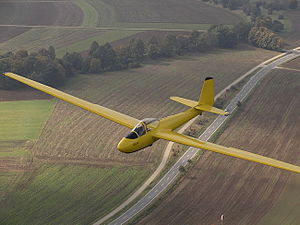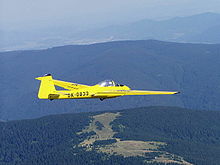Letov LF 107 Luňák
| Letov LF-107 Luňák | |
|---|---|

|
|
| Type: | Glider |
| Design country: | |
| Manufacturer: | |
| First flight: |
June 25, 1948 |
| Production time: |
1948 to? |
| Number of pieces: |
75 |
The Letov LF-107 Luňák ( German Milan ) is a powerful Czechoslovakian aerobatics - Glider , which in the late 1940s by Rudý Letov was developed and built.
history
The design was created in the LF development group headed by Vladimír Štros. These included Ing.K. Dlouhý, Ing.J. Matejcek, B. Roček and other, later known workers in the Czechoslovak aircraft industry and mostly also experienced glider pilots.
The first prototype was flown in on June 25th and 26th, 1948 and had the registration number OK-8730 . The second prototype received the registration number OK-8731 on July 18, 1948 . Both prototypes passed various flight and operational tests.
The Czechoslovak aircraft industry represented itself very well abroad, especially in Switzerland at the aircraft exhibition and in the competition in Grenchen in 1948 and in Žiar / Poland at the first competition of socialist glider pilots in 1949. Remarkable aerobatic properties, good performance and previously unseen Form solutions focused on the aircraft deserved attention.
After the success in Switzerland, the Ministry of National Defense of Czechoslovakia initiated the serial production of the Luňák. The start of serial production coincided with the considerably deteriorated international relations, when the industry was already starting to produce the Soviet MiG-15 and Il-10 . There was almost no time left for the production of the Luňák, which was carried out by Rudý Letov. Rudý Letov built a total of 75 aircraft, including the prototypes. They were characterized by high durability and a long service life of the construction and also made it possible to fly more demanding maneuvers.
Rudý Letov's first aircraft with registration OK-0800 flew in 1950 and differed in slightly larger dimensions, simpler construction and a newly worked cabin.
The delivery of the LF-107 Luňák glider (military designation VT-7) made of wood to the aeroclubs added a powerful glider to their aircraft fleet and contributed to the wider spread of aerobatics .
The Czechoslovak glider pilots took part with the Luňák in many domestic and foreign flight days and competitions. Particularly noteworthy was the performance of the aerobatic groups from Bratislava and Vrchlabí (e.g. simultaneous torn role in the F-tow of glider and tow plane ).
The Luňák was used for aerobatic training in the Soviet Union , Bulgaria , Romania and Poland.
The first prototype later flew in the UK and a Luňák came to the USA . On August 28, 1951, the prototype of a new glider that was very similar to the Luňák flew in Prague-Letňany . It was the XLF-207 Laminar. It was one of the first motorless aircraft in the world to have a laminar profile , which was developed by LF.
present
There are probably nine airworthy specimens left.
Technical specifications
| Parameter | Data |
|---|---|
| span | 14.27 m |
| length | 6.78 m |
| Wing area | 13.38 m² |
| Wing extension | 15.22 |
| Wing loading | 23.2 kg / m² |
| Wing profile | NACA 23012 |
| Preparation mass | approx. 205 kg |
| Payload | Max. 105 kg |
| Max. Takeoff mass | 310 kg |
| Wing loading | 23.17 kg / m² |
| Top speed | 300 km / h |
| Stall speed | 50 km / h |
| slightest sinking | 0.85 m / s at approx. 65 km / h |
| Glide ratio | 24 at 80 km / h |
See also
literature
- Martin Simons: Gliders . 1945-1965. 4th edition. Eqip, Bonn 2017, ISBN 3-9807977-3-2 , p. 45-48 .
Web links
Individual evidence
- ^ Letov LF-107 : Description page of the exhibit in the Museum of Flight , Seattle
